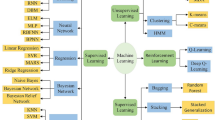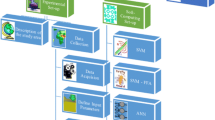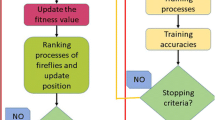Abstract
An accurate and reliable forecast of biosurfactant production with minimum error is useful in any bioprocess engineering. Bacterial isolate FKOD36 capable of producing biosurfactant was isolated in this study and pre-inoculums was prepared from the agar slants in a small test tube and incubated at 30 °C for 24 h at 120 rpm. Due to inherent non-linearity characteristics of the data set in a bioprocess, conventional modeling techniques are not adequate for predicting biosurfactant production in a microbiological process. The main contribution of the study was to compare two soft-computing models, i.e., support vector regression (SVR) and support vector regression coupled with firefly algorithm to evaluate the best performance of the two mentioned models. Based on the results it was noted that support vector regression coupled with firefly algorithm performs better compared to the simple SVR.

Similar content being viewed by others
References
Shimizu K (1996) A tutorial review on bioprocess systems engineering. Comput Chem Eng 20(6–7):915–941
Geetha SJ, Banat IM, Joshi SJ (2018) Biosurfactants: production and potential applications in microbial enhanced oil recovery (MEOR). Biocatal Agric Biotechnol 14:23–32
Jadav S, Sakthipriya N, Doble M, Sangwai JS (2017) Effect of biosurfactants produced by Bacillus subtilis and Pseudomonas aeruginosa on the formation kinetics of methane hydrates. J Nat Gas Sci Eng 43:156–166
Hajibagheri F, Hashemi A, Lashkarbolooki M, Ayatollahi S (2018) Investigating the synergic effects of chemical surfactant (SDBS) and biosurfactant produced by bacterium (Enterobacter cloacae) on IFT reduction and wettability alteration during MEOR process. J Mol Liq 256:277–285
Shah MUH, Moniruzzaman M, Sivapragasam M, Talukder MMR, Yusup SB, Goto M (2019) A binary mixture of a biosurfactant and an ionic liquid surfactant as a green dispersant for oil spill remediation. J Mol Liq 280:111–119
Pacwa-Płociniczak M, Płociniczak T, Iwan J, Żarska M, Chorążewski M, Dzida M, Piotrowska-Seget Z (2016) Isolation of hydrocarbon-degrading and biosurfactant-producing bacteria and assessment their plant growth-promoting traits. J Environ Manag 168:175–184
Jha SS, Joshi SJ, G SJ (2016) Lipopeptide production by Bacillus subtilis R1 and its possible applications. Braz J Microbiol 47(4):955–964
Gudina EJ, Pereira JF, Costa R, Coutinho JA, Teixeira JA, Rodrigues LR (2013) Biosurfactant-producing and oil-degrading Bacillus subtilis strains enhance oil recovery in laboratory sand-pack columns. J Hazard Mater 261:106–113
Sivasankar P, Kumar GS (2017) Influence of pH on dynamics of microbial enhanced oil recovery processes using biosurfactant producing Pseudomonas putida: mathematical modelling and numerical simulation. Biores Technol 224:498–508
James S, Legge R, Budman H (2002) Comparative study of black-box and hybrid estimation methods in fed-batch fermentation. J Process Control 12(1):113–121
Yu X, Liong S, Babovic V (2004) EC-SVM approach for real-time hydrologic forecasting. J Hydroinform 6:209–223
Chang C-C, Lin C-J (2002) Training nu-support vector regression: theory and algorithms. Neural Comput 14(8):1959–1978
Muller KR, Smola AJ, Ratsch G, Scholkopf B, Kohlmorgen J, Vapnik V (1999) Using support vector machines for time series prediction, advances in kernel methods—support vector learning. MIT Press, Cambridge, pp 243–254
Schölkopf B, Burges CJ, Smola AJ (1999) Advances in kernel methods: support vector learning. MIT press, Cambridge
Yang XS (2009) Firefly algorithms for multimodal optimization. In: Stochastic algorithms: foundations and applications. Springer, Berlin, Heidelberg, pp 169–178
Ch S, Sohani S, Kumar D, Malik A, Chahar B, Nema A, Panigrahi BK, Dhiman R (2014) A support vector machine-firefly algorithm based forecasting model to determine malaria transmission. Neurocomputing 129:279–288
Author information
Authors and Affiliations
Corresponding author
Ethics declarations
Conflict of interest
The authors declare that they have no conflict of interest.
Additional information
Publisher's Note
Springer Nature remains neutral with regard to jurisdictional claims in published maps and institutional affiliations.
Rights and permissions
About this article
Cite this article
Jovic, S., Guresic, D., Babincev, L. et al. Comparative efficacy of machine-learning models in prediction of reducing uncertainties in biosurfactant production. Bioprocess Biosyst Eng 42, 1695–1699 (2019). https://doi.org/10.1007/s00449-019-02165-y
Received:
Accepted:
Published:
Issue Date:
DOI: https://doi.org/10.1007/s00449-019-02165-y




